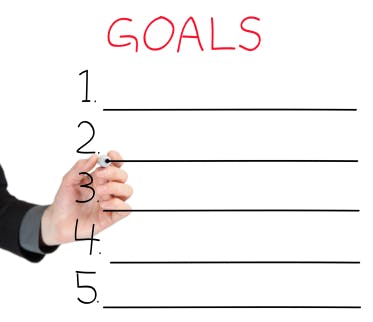Goals are all around us.
The finish line in a race is the most obvious example, but you might also see them in nutrition guidelines, a train schedule or as an actual goal on a soccer field.
In the business world, goals are the foundation of a high performance culture. They give employees direction and purpose, and, when done correctly, serve as a motivator.
Of course, goals need specific ingredients to be effective.
A basketball game without baskets would be boring and uneventful. Flights that could land at any airport within 100 miles of your destination wouldn’t be very useful.
The same is true for your company. Your employees aren’t likely to succeed if your business goals don’t include the necessary pieces of information for success.
How goals can break down
To help understand how to set good business goals, imagine these situations:
- Races Without Finish Lines — Every runner dreams of breaking the tape at the finish line of a big race, but what if there was no finish line? What if races didn’t have designated distances? The simple answer is that without finish lines, we wouldn’t know who won. Runners wouldn’t no how fast or slow they should run or how far to go. Even worse, without finish lines, running would lack the challenge that motivates runners.
Takeaway — Setting goals with concrete targets helps define when a goal is achieved and serves as motivation for achieving it.
- Vague Dietary Guidelines — The FDA educates the public on several factors that contribute to a healthy diet. What if instead of outlining the target calories per day, servings of each food group, suggested amounts of each nutrient and adjustments for different body types, they only gave us one of these important pieces of information? You might shoot for 2000 calories, but you would get too much fat and not enough protein. Maybe you would get to the right protein amount, but without having any vegetables, you’d miss out on other key nutrients. Without each key detail, we wouldn’t have a good roadmap towards a balanced diet.
Takeaway — Goals need to include important details such as what you want achieved and how. The best goals are also tailored to the specific person or team that will own them.
- Universal Speed Limits — What if we had one speed limit for all driving situations and conditions? While this might seem fun, it would either be dangerous or inconvenient – going 55 MPH in a school zone is a terrible idea and you wouldn’t get very far with a 25 MPH limit on the highway. Further, roads change – we add lanes, or build neighborhoods around them. If speed limits didn’t account for each road’s unique and changing characteristics, they would result in dangerous driving conditions.
Takeaway — Goals should account for specific circumstances and include reasonable targets. Over time, goals should be recalibrated regularly as situations change.
- Trains Without Schedules –What if trains didn’t share their schedules and ran as they pleased? You would never know when to get on one, and would have no idea when you would actually arrive at your destination. Still, as long as they got your from point A to point B eventually, the ride would be considered a success. By communicating an arrival time, you have an expectation that you can use to measure whether or not the train did good job of getting you where you wanted to go.
Takeaway — Goals need deadlines so that you can prioritize them with other goals, and know if you achieved them in a timely manner.
Getting the right elements
Setting an effective goal can be the difference between average and great performance. Fortunately, with the right elements, creating a well-defined goal doesn’t have to be a difficult exercise.
How do you ensure that your goals include these key elements?
This originally appeared on the PerformYard.com blog
